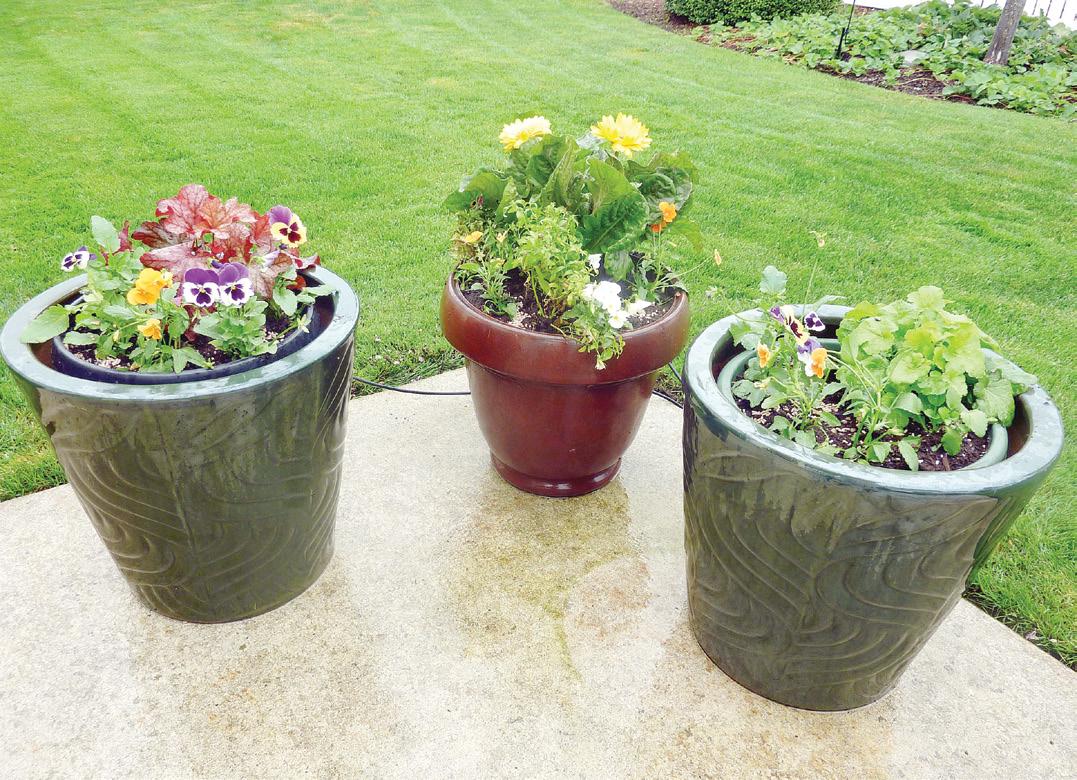
4 minute read
Forest gardens
By shauna dobbie
As I started to research forest gardens, my hair started to grow long and my clothes all turned to homespun cotton. This is definitely a topic with hippie appeal.
Advertisement
Originating in tropical areas such as India and Indonesia, forest gardening was adapted to temperate climates in the 1980s by Robert Hart. The idea is to grow many different types of food and other useful plants and trees in the same area. Food crops should be perennials or at least selfseeding annuals. You can maintain small animals that have a symbiotic relationship with the garden in this area too, such as chickens and bees. By gardening this way, you use less human energy to sustain your diet. Hart was able to produce enough fruits, nuts and leafy vegetables for himself and his brother (vegans) on a 0.12-acre plot of land.
The idea hasn’t really caught on. After all, do you know of anyone who has a forest garden in your neighbourhood? But there are several people in Canada who are market-farming using at least some of the principles of forest gardens. And some of the principles may work for you, particularly in a home garden.
We’ll start with the largest of the forest-gardening plants, the trees. In cooler areas, you are unlikely to have large nut trees; even in southern Ontario, Zone 6 is the cut-off for Persian walnuts, chestnuts and largersized European hazel nuts. The smaller-nutted native hazels, hardy across Ontario, Manitoba and Alberta, are smaller shrubs.
The largest food-producing trees are likely to be pears and apples, at about 30 feet high, and plums, cherries, saskatoons and apricots a little shorter. The arrangement of these trees would depend on your space, but it is best to plant them to the north of your other things.
Just south of your apple trees, you would have raspberry and gooseberry shrubs; this is where you would grow hazelnuts as well.
South of the hazelnuts and berries, you can grow asparagus, walking onions, chives, sorrel and rhubarb.
Forest gardening. And south of these you can grow strawberries.
These are some of the plants that will feed you, but you also need to feed the soil. The tree leaves will drop and the plants will die in the fall and return to the earth. You should also plant nitrogen-fixing plants. You can either plant vetch and lupins, which are inedible legumes, or you can plant beans and peas, which you’ll have to replant each year.
To make your garden a food forest, you can’t plant everything in rows. You need to space the trees and shrubs out and you will grow the smaller plants around them.
You will need to install paths so that you can access the food, because you shouldn’t trample the soil. This isn’t
The seven layers of a forest garden
Illustration by Graham Burnett.

1. Canopy layer (large mature fruit and nut trees) 2. Low tree layer (dwarf fruit trees) 3. Shrub layer (currants, berries) 4. Herbaceous layer (perennial vegetables, herbs and grains) 5. Rhizosphere (root layer) 6. Groundcover layer (soil surface) 7. Vertical layer (climbing plants)
for spiritual reasons; trampling the soil condenses it, undoing all the hard work done by earthworms and their ilk.
In concept, everything in your food forest works together. Beneficial insects, birds and animals come to control pests. Dead plant matter decomposes, feeding the garden. If you add some chickens, they will also eat bugs and poop out fertilizer. You plant thickly enough so that the occasional weed that comes up you can just leave because it surely does something to support pollinators or attract other insects.
In its purest form, the forest garden sounds like Eden. In temperate climates, it doesn’t function in its purest form though, and thank goodness; I couldn’t live on a constant diet of chicken, apples, rhubarb and sorrel.
Most people would want to add some annual vegetables to the mix— or at least vegetables we grow as annuals here—like corn, lettuce, broccoli, tomatoes and potatoes. You would need an area you are willing to dig in at least a little bit to do that.
I do wonder about “not planting in rows”. Why couldn’t you plant rows, even circular rows, of veg in front of shrubs? The reason that “nature doesn’t do that” isn’t compelling enough. Nature doesn’t group human-edible foods together either. The reason that “any kind of order requires unnecessary energy” makes more sense, but I know people who would spend more energy upset about the lack of order than what energy they’d put into imposing some.
There is an article by Graham Strouts, a Welshman trained as an agroforester, online, in which he is quite critical of forest gardening. He has designed several and visited others, he says, and never found them living up to his expectations. He makes some good arguments. Several replies to his post make the case for forest gardening despite his criticisms.
Ultimately, it doesn’t matter so much what anyone else thinks. If some or all of the ideas of edible forest gardening appeal to you, go ahead and give it a try. If not, on to the next idea. h
Do you have a food forest garden? We’d like to hear from you. Write to shauna@ pegasuspublications.net. I’ll come for a visit next summer to find out more!
What is a forest garden? Find out more info here.
www.treehugger.com/lawn-garden/ what-forest-garden.html Scan me
Permaculture and the edible forest garden: a critical analysis.
https://theculturalwilderness.wordpress. com/2016/03/26/permaculture-and-the-edibleforest-garden-a-critical-analysis/










